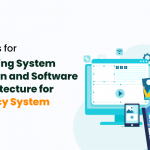Collaborative Architecture Design: Fostering Team Cohesion and Productivity
Your organization is surely composed of numerous departments and teams with a distinct set of functions for each. You have an R&D team that creates the blueprint of a competitive edge software, while DevOps deals with building its prototypes. The marketing team focuses on promoting the product, and the customer success team works on providing unique CX to clients.
But will your business succeed if all these departments start functioning in silos? OR are you sure if all your team are working to achieve the same goal? If your teams are not aligned on their goals and direct resources in diverse directions, you will soon be out of business.
Building a Cross-functional team can be a solution, which can help you to optimize your efforts toward a common goal. But how do you create a cross-functional team that fosters cohesion and productivity? Let’s understand in detail.
Methodologies For Involving Cross-Functional Teams in Architecture Decisions
Introducing cross-functional teams in your architectural design can be a good decision that can help you foster team cohesion and productivity. Here are some ways of doing it:
Workshops and Collaborative Sessions before Architecture Design Sessions (ADS):
ADS are focused workshops where stakeholders from various departments come together to brainstorm and design architectural solutions. With this initiative, you can encourage active participation of your teams, idea generation, and collective ownership of the architecture. Workshops and collaborative sessions prior to architecture design can significantly enhance team collaboration by bringing your team members together, allowing them to share their perspectives, goals, and constraints. When your team has a shared understanding with everyone on the same page, it reduces misunderstandings later on.
Additionally, open discussions during such workshops promote better communication among team members, which fosters a culture of openness among teams. Team discussions encourage individual contributors to voice their opinions and concerns, leading to better solutions.
The scope of iterations is another benefit of ADS, which encourages the continuous improvement and refinement of the product’s architecture. It is a software architecture best practice to build a product with an iterative approach as it can develop more robust and adaptable architectural designs.
Include Agile and Scrum Practices in SDLC
Forming teams with a mix of skills is necessary to deliver a feature or part of the architecture to ensure that diverse perspectives are instilled in the design from the initial planning stages. For example, frequent sprint reviews offer an opportunity for stakeholders and team members from different domains to evaluate the architecture’s impact on the product. Similarly, creating a feedback loop will enable you to modify the design based on diverse inputs, ensuring your architecture aligns with the project’s evolving needs.
Agile and Scrum practices in SDLC promote adaptability and flexibility in response to changing requirements. By breaking down your architecture design process into smaller, manageable chunks (Sprints), teams can regularly reassess and adapt the architecture based on feedback, new insights, or shifting priorities. Hence, you start working on an iterative approach to foster continuous improvement and adjustment, leading to a more refined and effective architectural design.
Establishing Communities of Practice (CoPs) like Architecture Guilds/Communities:
Establish a forum where architects, developers, testers, and other stakeholders initiate brainstorming sessions on architectural patterns, best practices, and challenges. Building guilds and communities can encourage continuous learning and sharing of insights and foster a sense of community ownership over architectural decisions. CoPs can significantly promote and enhance cross-functional teams by providing a space where members can collaborate on solving complex problems or challenges that require cross-functional input. By leveraging the collective expertise of individuals from different areas, CoPs enable more comprehensive and innovative solutions to emerge.
Often, different functions within an organization operate in silos. CoPs encourage interaction and collaboration among individuals who might not typically work together. CoPs provide opportunities for cross-training and skill development. Members can learn from each other, gaining insights into different functions or domains. Hence, individual skill sets will broaden, and a better understanding of the challenges and opportunities across various areas within your organization will also be promoted.
Furthermore, when cross-functional teams are involved in CoPs, it improves collaboration within projects. Team members who regularly engage in CoPs have established relationships and a deeper understanding of each other’s expertise, making it easier to collaborate effectively on projects that require diverse skills and inputs.
Engaging in Prototyping and Proof of Concepts (POCs):
Forming small, multidisciplinary teams to work on prototypes or POCs related to the architecture is a hands-on approach that will encourage diverse team members to contribute ideas and perspectives in the early stages of solution design. Creating prototypes often requires collaboration between designers, developers, engineers, and other specialists. Each team member contributes unique skills, perspectives, and knowledge, fostering a collaborative environment. Hence, this step can facilitate a shared understanding of the project’s goals and requirements among team members from other functions or domains.
Prototyping and POC development require clear communication and collaboration among team members. Through this process, team members learn to communicate effectively, share ideas, and work towards a common goal. Moreover, during the prototyping phase, cross-functional teams can identify potential issues or challenges early. With early detection, you can enable swift resolution by leveraging the collective expertise of team members from different areas.
While building POCs, you can parallelly assess the feasibility and viability of ideas or solutions before their full-scale implementation. Hence, not only can your team test concepts early, they will also be able to mitigate risks and make informed decisions, reducing potential setbacks that may retard your business growth down the line.
Streamline Communication and Documentation Process between Teams
Promoting thorough documentation and effective communication among the system architects and cross-functional teams can enhance collaboration, which can help you successfully develop and maintain system architectures. Developing a practice of visual documentation process among teams by creating diagrams, flowcharts, or visual representations of the architecture can facilitate better understanding among cross-functional teams, making complex concepts accessible to a broader audience.
When you have an interactive communication process, new team members can quickly get up to speed with the intricacies of the project. This accelerates the onboarding process, allowing them to understand the system architecture and start contributing effectively in a shorter time frame. Detailed documentation further helps team members understand the system architecture regardless of their specialized areas. A shared understanding is vital for effective collaboration as it allows everyone to speak the same language and comprehend the overall structure, components, and interactions.
As system architectures evolve, documented communication helps understand the changes and adapt accordingly. It aids in scaling the system as needed by providing insights into potential areas for expansion or improvement. Clear communication through documentation minimizes ambiguity in system requirements, design decisions, and functionalities. When everyone has access to well-documented information, misunderstandings, and misinterpretations are less likely to occur.
What Makes a Cross-Functional Team Productive?
For cross-functional teams to be more productive they should be able to operate independently in order to increase productivity. Your teams should be able to complete a project without the need for constant coordination or micromanagement. However, it’s important to stay informed and aware of progress. If goals are set clearly, there’s no need to interfere, and all tasks can be completed on time. While there may be someone reporting to a higher-ranking C-suite executive, mid-level managers may not always be necessary.
Many companies have found that creating a specific environment for cross-functional teams is essential for success. According to Deloitte’s survey, 73% of companies take this approach. However, it’s important to note that businesses don’t just jump into cross-functional development without a plan. Instead, 48% of developing companies and 29% of startups have gradually integrated cross-functional cooperation models through steady steps and concrete planning.
Regular re-evaluation of progress is essential. For instance, if the market shifts suddenly, you may have to abandon a project to save resources and redirect them towards something with better potential. Although it is tough, it is always safer and better to cut your losses early rather than continue down a path where you might have to incur losses.
If your software follows a microservice architecture, it might not be necessary to have ‘micro’ cross-functional teams as well. For example, Amazon uses the “two-pizza team” concept, where a team of around 12 can maintain a microservice. However, other setups may have half a dozen people supporting multiple services. The concept of self-contained systems suggests using services that are larger than microservices but still small enough to keep a team busy and provide significant value.
Conclusion:
Cross-functional teams are teams that work across different departments to boost collaboration and innovation. They became increasingly popular with the rise of technology. Cross-functional teams are known for their ability to generate creative ideas and innovations, and for delivering results in a timely manner – something that is valuable for every business. They help break down company silos, making collaboration more efficient and effective.
Finoit has a software development firm and provides your business with team augmentation and software development consultation services. To know how our certified professionals can help you have a more productive business, Get in touch with us today!


